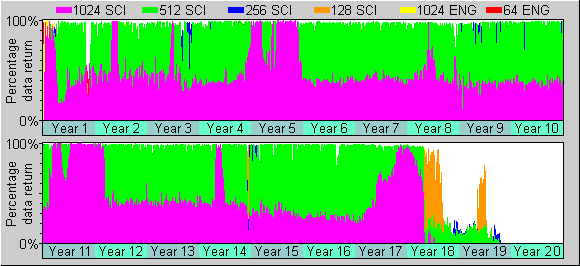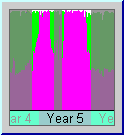Data Return Plots - Ulysses
Data Return

For most of its mission, Ulysses has been passing through regions of space that no other spacecraft has visited. This is due to its unique orbit out of the ecliptic plane and over the poles of the Sun. Data continuity has therefore been of prime importance since the spacecraft was launched in October 1990. An 18 year plot of the Ulysses data return broken down into the various bit rates is shown above.
Ulysses can provide four scientific real-time downlink data rates (128, 256, 512 & 1024 bps) and two engineering rates (64 & 1024 bps). During normal operations, approximately 16 hours of 512 bps and 8 hours of 1024 bps scientific data are returned each day. Note that the maximum data rate that can be recorded by the on-board tape recorders is 512 bps.
[Year 1 |Year 2 |Year 3 |Year 4 |Year 5 |Year 6 |Year 7 |Year 8 |Year 9 |Year 10]
[Year 11 |Year 12 |Year 13 |Year 14 |Year 15 |Year 16 |Year 17 |Year 18| |Year 19]
There have been a number of periods during the mission when the data return been significantly different from the standard requirements. These are listed below.

Following this was a month-long period of continuous tracking as the experiments were turned on one by one and checked out. Since the tape recorders were not in use, a scientific data rate of 1024 bps was maintained for most of this time. Some brief periods of engineering data were required, however, following the appearance of spacecraft nutation when the axial boom was deployed.
Continuous tracking was extended into December to monitor the nutation anomaly which coincidentally resulted in increased 1024 bps scientific data return. At the end of December, 24 hour coverage was also required during the First Opposition period.

The resulting reduction in science data return was tremendous. The Science Working Team therefore passed a resolution at its meeting in Heidelberg, Germany in April 1991 urging the two agencies to find a way to restore the expected data return. This was quickly achieved by increasing the Ulysses tracking requirements to 10 hours per day.

For a day either side of Conjunction, the data rate was also reduced to 128 bps and even 64 bps. This was because the interference to the downlink as it passed through the Sun's corona prevented higher bit rates from being received.

As a result, continuous tracking was required for a period of 8 days either side of closest approach on 8 February 1992. Indeed, dual station coverage was provided for four days around closest approach to ensure reception of this valuable data set. 1024 bps scientific data was obtained for the whole of the planetary encounter.
Second Opposition (27 February 1992) was the prime period for the Radio Science Gravitational Wave experiment. A requirement of 24 hour coverage for 28 days around opposition resulted in continuous tracking from the Jupiter fly-by period until 18 March. Once again, 1024 bps scientific data was returned throughout.



A fortunate consequence of this full-time coverage was that most data returned during the periods August 1994 - February 1995 and April - September 1995 were at 1024 bps. 512 bps data were returned only when DSN tracking was not possible (the Kourou 15 meter antenna was used instead during these times).

Continuous tracking was provided by the Deep Space Network for most of the period between 22 February and 14 March. Any gaps in coverage were filled by use of ESA's 15 meter antenna in Kourou. This resulted in increased 1024 bps scientific data return.
 Extra coverage was scheduled during early 1998 to support MIDAS (Multi-project Investigation During the Alignment of Spacecraft). The alignment of Ulysses and the ACE, POLAR, WIND and SOHO spacecraft around the Ulysses' 5th Opposition provided a unique opportunity for the study of the Evolution of Coronal Mass Ejections (CMEs), interstellar pickup ions and other phenomena.
Extra coverage was scheduled during early 1998 to support MIDAS (Multi-project Investigation During the Alignment of Spacecraft). The alignment of Ulysses and the ACE, POLAR, WIND and SOHO spacecraft around the Ulysses' 5th Opposition provided a unique opportunity for the study of the Evolution of Coronal Mass Ejections (CMEs), interstellar pickup ions and other phenomena.

- Removed a total of (2) style text-align:center;
- Removed a total of (4) style float:left;
- Removed a total of (5) style float:right;
- Removed a total of (1) border attribute.
- Converted a total of (11) center to div.








































 Sign in
Sign in
 Science & Technology
Science & Technology